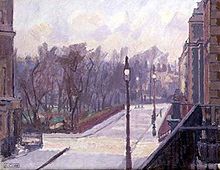Spencer Gore (artist)


Spencer Frederick Gore(26 May 1878 – 27 March 1914)[1]was a British painter of landscapes,music-hallscenes and interiors, usually with single figures. He was the first president of theCamden Town Group,[2]and was influenced by thePost-Impressionists.
Early years
[edit]He was born on 26 May 1878 atEpsomin Surrey, the youngest of the four children of theWimbledon tennis champion,Spencer Goreand his wife Amy Margaret (née Smith). His father's brother was the theologianCharles Gore.His father sent him to board atHarrow Schoolin Middlesex (now Greater London). He went on to study painting in London at theSlade School of Fine Art,where he was a contemporary ofHarold Gilman.
Painting career
[edit]In 1904 Albert Rutherston introduced Gore toWalter SickertatDieppe;and afterwards he associated in Fitzroy Street, London, with Sickert,Lucien Pissarro,Harold GilmanandCharles Ginner.In 1909 he became a member of theNew English Art Club,and in 1910 contributed an article toThe Art Newson "The Third London Salon of theAllied Artists Association".
In 1911 he was a co-founder and first president of theCamden Town Group.
In January 1912 he married Mary Joanna ( "Molly" ) Kerr, with whom he had two children – Margaret Elizabeth (1912–1994) and Frederick John Pym (1913–2009); the latter would become well known as the painterFrederick Gore.His widow died atMeopham,Kent in 1968.[3]
In 1913 he became a member of theLondon Group.
His later works show growing concern with pictorial construction, under the influence of thePost-Impressionists.He experimented with colour in his works, as may be seen in his paintingHartington Square.
Gore painted a series of thirty-two landscapes inRichmond Parkduring the last months of his life.[4]His paintingFrom a Window in Cambrian Road, Richmond[5]shows the view from a top-floor window at the rear of 6 Cambrian Road, near the park's Cambrian Gate entrance, where he and his family moved to in 1913.[6][7]This may be the last picture Gore worked on before his death.[7]According to Tate curator Helena Bonett, Gore's early death frompneumonia,two months before what would have been his 36th birthday, was brought on by his painting outdoors in Richmond Park in the cold and wet winter months.[8]
Gore's paintingRichmond Park,thought to have been painted in the autumn of 1913 or shortly before the artist's death in March 1914, was exhibited at the Paterson and Carfax Gallery[9]in 1920. In 1939 it was exhibited inWarsaw,HelsingforsandStockholmby theBritish CouncilasGroup of Trees.[10]It is now in the collection of theTate Galleryunder its original title but is not currently on display.[10]It is not certain where in the park the picture was made but a row of trees close to the pond near Cambrian Gate has a very close resemblance to those in the painting.[11]Another Gore painting, with the same title (Richmond Park), painted in 1914, is at the Ashmolean Museum. His paintingWood in Richmond Parkis in theBirmingham Art Gallery's collection.[12]
Two of Gore's artworks,Brighton PierandRichmond Houses,appear in the first number of the landmark modernist journal,BLAST,published some three months after Gore's death.[13]There features also an obituary piece byWyndham Lewis,who edited the magazine, and who eulogises Gore's "dogged, almost romantic industry, his passion for the delicate objects set in the London atmosphere around him, his grey conception of the artist's life, his gentleness and fineness, [which] would have matured into an abundant personal art".[14]
He died atRichmond, Surrey,on 27 March 1914, aged 35 and was buried inHertingfordburyin Hertfordshire, where his mother lived.[15]
Teaching
[edit]Spencer Gore gaveJohn Doman Turnerartistic training from 1908 to 1913 in a series of thirty letters. The teaching was probably carried out via correspondence because Doman Turner was deaf. The letters are now held in the Gore family collection. Doman Turner was a member of the Camden Town Group, having been elected by Gore, but was shy and unsure of his abilities, which probably led him to resign his membership of the London Group soon after it was formed on 27 November 1913.[16]
Bibliography
[edit]- Bonett, Helena. "Spencer Gore 1878–1914", artist biography, September 2009, in Bonett, Helena; Holt, Ysanne; Mundy, Jennifer (eds.),The Camden Town Group in Context,Tate, May 2012,tate.org.uk
- Upstone, Robert.Modern Painters: The Camden Town Group,exhibition catalogue,Tate Britain,London, 2008.ISBN1-85437-781-7
References
[edit]- ^Spalding, Frances, "Spencer Gore", Oxford Art Online
- ^Bonett, Helena (September 2009).Spencer Gore 1878–1914, artist biography.in Bonett, Helena; Holt, Ysanne; Mundy, Jennifer (eds.) The Camden Town Group in Context, May 2012.ISBN9781849763851.Retrieved1 December2014.
- ^"Person Page".
- ^"Richmond Park by Spencer Gore".Art UK.Retrieved9 January2019.
- ^"'From a Window in Cambrian Road, Richmond', Spencer Gore ".Tate.Retrieved26 June2019.
- ^Upstone, Robert (May 2009)."Spencer Gore: Richmond Park c.1914".The Camden Town Group in Context.Tate.Retrieved17 October2012.[permanent dead link]
- ^abUpstone, Robert (May 2009)."Spencer Gore: From a Window in Cambrian Road, Richmond 1913".The Camden Town Group in Context.Tate.Archived fromthe originalon 3 August 2012.Retrieved17 October2012.
- ^Bonett, Helena (September 2009).Spencer Gore 1878–1914.Tate.ISBN9781849763851.Retrieved16 October2012.
- ^"Carfax Gallery".Artist Biographies: British and Irish Artists of the 20th Century.Retrieved17 October2012.
- ^ab"Spencer Gore: Richmond Parkc.1914 ".Tate.Retrieved15 March2019.
- ^Robert Upstone (May 2009).Spencer Gore:Richmond Parkc.1914.Tate Gallery.ISBN9781849763851.Retrieved17 October2012.
{{cite book}}:|work=ignored (help) - ^"Wood in Richmond Parkby Spencer Gore ".Art UK.Retrieved16 October2012.
- ^"Blast (no 1)".The Modernist Journals Project.Retrieved19 October2016.
- ^"Blast (no 1)".The Modernist Journals Project.Retrieved19 October2016.
- ^"Spencer Gore".Epsom and Ewell History Explorer.Retrieved31 January2016.
- ^Turner, John Doman (1 May 2012).Letter to James Bolivar Manson.ISBN9781849763851.
External links
[edit]![]() Media related toSpencer Goreat Wikimedia Commons
Media related toSpencer Goreat Wikimedia Commons
